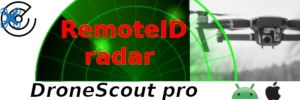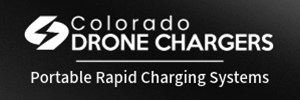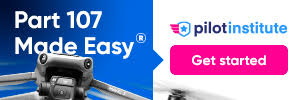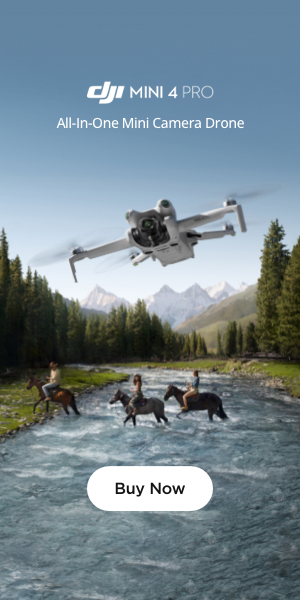Aperture setting on Mavic Pro is "stuck" on f/2.2. With camera selected and set to Manual, I can set ISO and shutter speed but the Aperture setting appears to be inactive. I am using Litchi. Any assistance is appreciated. Peter vdB
You are using an out of date browser. It may not display this or other websites correctly.
You should upgrade or use an alternative browser.
You should upgrade or use an alternative browser.
Aperture setting
- Thread starter Peter vdB
- Start date
That's due to that a Mavic Pro have a fixed aperture ... you can't adjust it.Aperture setting on Mavic Pro is "stuck" on f/2.2. ... Aperture setting appears to be inactive. I am using Litchi.
- Joined
- May 25, 2017
- Messages
- 8,476
- Reactions
- 7,966
- Age
- 63
Thanks for that, to get around it I will need to make necessary adjustments to S/Speed and ISO to accommodate
For photos, or video ?
Edit - welcome to the forum too.
- Joined
- May 25, 2017
- Messages
- 8,476
- Reactions
- 7,966
- Age
- 63
for taking photos
Ok, so are you having trouble taking photos in certain conditions ?
Generally in low light all the fixed aperture camera drones have a little trouble getting clear sharp images, low noise etc.
For general daytime photos, the M1P does a reasonable job.
You've only just got this drone ?
Or had it a while ?
It is fairly old and been obsolete for a couple of years now, but they are still a very solid drone to fly, and use for photos / video.
I still use GO4, the original DJI app, though Litchi has a very good reputation for it's autonomous mission planning.
Cymruflyer
Well-Known Member
its the Mavic 2 Pro that has the adjustable aperture settings, not the Mavic Pro. Maybe you got confused when you bought it. Don't forget to focus as well, before you start shooting, just to be on the safe side.
My son, who lives in US has used it for some time and dropped it off in South Africa for me to have some fun with. I have been doing wildlife photography for a number of years and have some excellent equipment. I was hoping to add to this with some drone photography but by the sound of things quality images could be out of the question so I might have to resort to using it for fun. It could possibly result in an upgrade.its the Mavic 2 Pro that has the adjustable aperture settings, not the Mavic Pro. Maybe you got confused when you bought it. Don't forget to focus as well, before you start shooting, just to be on the safe side.
Thanks for your input, appreciate it.
I'm not sure what you think that an adjustable aperture on a drone camera will do for the picture quality ......but by the sound of things quality images could be out of the question so I might have to resort to using it for fun.
But it's a fact that on a drone the focus depth will be endless no matter what aperture you chose. The aperture setting is mainly good for one thing when you have it on a drone ... to slow the shutter down so you might not need a ND filter to get correct exposures when trying to keep to the 180 degree rule for a natural motion blur when videoing. You can't draw parallels regarding the aperture setting comparing the camera on a drone & a DSLR.
- Joined
- May 25, 2017
- Messages
- 8,476
- Reactions
- 7,966
- Age
- 63
I was hoping to add to this with some drone photography but by the sound of things quality images could be out of the question
Give it a go, you might need to play with settings a bit to get the best from it, and always touch the screen to focus on whatever spot you are looking at, the auto focus might need a little help sometimes.
For really serious drone photography, you could find something in the Phantom 4 Pro, but I think it's been discontinued now (stock would still be around I'm sure).
Then the same with the Mavic 2 Pro, it seems to have been discontinued, an excellent camera with lots more flexibility.
Step up to something in the Inspire 2 which has camera options exceeding more hobbyists needs, and a price tag to match.
The new Mavic 3 is good on paper, really good, but has had its teething issues, so sometime soon that may be an option that will be around a few years at least.
You can certainly learn on a Mavic Pro, if you get to the stage of taking the best photos you can with that, when you step up to more current drones you will find the quality leap with your skills on the menus / control sticks etc well established.
Edit - I can't overlook the Air 2S, which has a 1" sensor camera, and takes a pretty good photo despite its fixed aperture.
It would be entry level good camera drone, then the M2P, P4P, Inspire options.
Last edited:
ivashchilov
New Member
Hi! Could you probably explain why "on a drone the focus depth will be endless no matter what aperture you chose"?I'm not sure what you think that an adjustable aperture on a drone camera will do for the picture quality ...
But it's a fact that on a drone the focus depth will be endless no matter what aperture you chose. The aperture setting is mainly good for one thing when you have it on a drone ... to slow the shutter down so you might not need a ND filter to get correct exposures when trying to keep to the 180 degree rule for a natural motion blur when videoing. You can't draw parallels regarding the aperture setting comparing the camera on a drone & a DSLR.
Both longer focus distances, shorter focal lengths (wide angle lenses) & smaller sensors makes the DoF wider in general... all these factors hugely affect drone photography/videoing, this to the degree that a bigger aperture can't mitigate the generated wide DoF.Hi! Could you probably explain why "on a drone the focus depth will be endless no matter what aperture you chose"?
Cymruflyer
Well-Known Member
The focus depth won't necessarily be endless, as you image, it will however, be greater when focusing on distance subject matter. The main reason is because you never use a drone for close up photography. Virtually ALL drone photography will be landscape photography and rarely with anything in your frame being close to the camera and far away. That means just about all your video and photography is of things far away. The distance from the lens to the subject matter determines what the visuals are of your depth of field which is determined by your aperture setting.
When you have a depth of field of, say, f2, depending on what lens you have chosen, you might have a depth of field (which means the range of in focus subject matter from the central focused point to the edge limits, in front of and behind, that focus point) of anywhere from a few inches, to tens or hundreds of feet. We are only concerned with f-stops in the low end such as from f1.8 to about f5.6 here.
With a telephoto lens the depth of field range will usually be smaller, or better stated, shorter, and the focus point will be more critical. With that said, most drone photography is not done with a longer telephoto type lens.
When using a wider angle lens, the point of focus, although still critical, is not as critical as with a telephoto lens, because there is soooo much more area in view of a wide-angle lens. That means the D.O.F. of a wide-angle lens is going to be greater. So, much more in front of and behind the point of focus, will be included in the sharp range of the image. The greater the distance of the subject focused on, from the lens, the greater your D.O.F will be.
That is why your D.O.F. is not too critical when doing drone photography or video, because, for the most part, all subject matter is going to be far away from the lens, which means the D.O.F is going to be less critical compared to focusing on something very close to the lens. from a drone, you might be focusing on something that is a mile or more away, so, from that point onwards towards infinity, everything will be in the range of focus from that focus point of your subject. Also, everything from that point of focus, towards the lens, will for the most part, be more in focus, compared to shooting through a longer telephoto lens.
I hope that is understandable for you. It would be the same if standing on the ground and shooting with a wide angle lens or a telephoto lens. The wider angle lens will have a greater depth of field (range of area in focus) from the point you have focused on to the limit range in from of and behind that point, which you chose to focus on.
If you are able to understand what I have just described, the easiest way to envision the depth of field would be like this. You have a volume of dough on a table. The big clump of dough is the light that must past through a lens aperture and is directly related to the size of the aperture.
If you have a large cake pan on the table, that is for argument sake, a wide angle lens with a wide aperture of, say f1.8 you can smash down that volume of dough, to a not very thick mass, allowing it to fit through that cake pan's wide circle. That relatively thin but wide volume of dough, is your depth of field, the area above and below the middle of that clump, so the focus point would be the centre of that flattish clump of dough. The point where the filling would be in a 2 layer cake.
If you have a very small cake pan, say the diameter of the size of a cup cake, this would be your smaller aperture of, say f22. Now, you still need to pass the same volume of dough through that smaller hole or smaller aperture. However, you cannot leave it in the shape of that large cake pan, you just had it.
Therefore, the only way to get that volume to pass through that cupcake size hole, or aperture, is to roll out that dough into a much thinner but longer strip on the table. Rolling it until it gets to the thinner thickness of the hole size of your cupcake. It is still the same volume of dough as before; however, it is now very long in comparison.
This new length, for argument sake, would be the dept of field, or length of subject matter in focus when using that smaller f22 aperture. Again, the point of focus would be the middle of the strip/length of dough, that you just rolled out. The D.O.F. limits would be the length of dough to the left and right of that middle point of your strip, or for us in photography, in front of and behind, the point that you focused on, in your landscape photo scene. Apologies for the long explanation.
When you have a depth of field of, say, f2, depending on what lens you have chosen, you might have a depth of field (which means the range of in focus subject matter from the central focused point to the edge limits, in front of and behind, that focus point) of anywhere from a few inches, to tens or hundreds of feet. We are only concerned with f-stops in the low end such as from f1.8 to about f5.6 here.
With a telephoto lens the depth of field range will usually be smaller, or better stated, shorter, and the focus point will be more critical. With that said, most drone photography is not done with a longer telephoto type lens.
When using a wider angle lens, the point of focus, although still critical, is not as critical as with a telephoto lens, because there is soooo much more area in view of a wide-angle lens. That means the D.O.F. of a wide-angle lens is going to be greater. So, much more in front of and behind the point of focus, will be included in the sharp range of the image. The greater the distance of the subject focused on, from the lens, the greater your D.O.F will be.
That is why your D.O.F. is not too critical when doing drone photography or video, because, for the most part, all subject matter is going to be far away from the lens, which means the D.O.F is going to be less critical compared to focusing on something very close to the lens. from a drone, you might be focusing on something that is a mile or more away, so, from that point onwards towards infinity, everything will be in the range of focus from that focus point of your subject. Also, everything from that point of focus, towards the lens, will for the most part, be more in focus, compared to shooting through a longer telephoto lens.
I hope that is understandable for you. It would be the same if standing on the ground and shooting with a wide angle lens or a telephoto lens. The wider angle lens will have a greater depth of field (range of area in focus) from the point you have focused on to the limit range in from of and behind that point, which you chose to focus on.
If you are able to understand what I have just described, the easiest way to envision the depth of field would be like this. You have a volume of dough on a table. The big clump of dough is the light that must past through a lens aperture and is directly related to the size of the aperture.
If you have a large cake pan on the table, that is for argument sake, a wide angle lens with a wide aperture of, say f1.8 you can smash down that volume of dough, to a not very thick mass, allowing it to fit through that cake pan's wide circle. That relatively thin but wide volume of dough, is your depth of field, the area above and below the middle of that clump, so the focus point would be the centre of that flattish clump of dough. The point where the filling would be in a 2 layer cake.
If you have a very small cake pan, say the diameter of the size of a cup cake, this would be your smaller aperture of, say f22. Now, you still need to pass the same volume of dough through that smaller hole or smaller aperture. However, you cannot leave it in the shape of that large cake pan, you just had it.
Therefore, the only way to get that volume to pass through that cupcake size hole, or aperture, is to roll out that dough into a much thinner but longer strip on the table. Rolling it until it gets to the thinner thickness of the hole size of your cupcake. It is still the same volume of dough as before; however, it is now very long in comparison.
This new length, for argument sake, would be the dept of field, or length of subject matter in focus when using that smaller f22 aperture. Again, the point of focus would be the middle of the strip/length of dough, that you just rolled out. The D.O.F. limits would be the length of dough to the left and right of that middle point of your strip, or for us in photography, in front of and behind, the point that you focused on, in your landscape photo scene. Apologies for the long explanation.
ivashchilov
New Member
What is the idea of having various apperture on these drone then? Just a lighness\darkness level adjustment?Both longer focus distances, shorter focal lengths (wide angle lenses) & smaller sensors makes the DoF wider in general... all these factors hugely affect drone photography/videoing, this to the degree that a bigger aperture can't mitigate the generated wide DoF.
You can with a smaller aperture (less light in) "force" a longer shutter to compensate & by that get a smother video clip by introducing a small amount of motion blur... this is why you might need ND filters on fix aperture cameras.What is the idea of having various apperture on these drone then? Just a lighness\darkness level adjustment?
Cameras have had controllable aperture for more than a hundred years, just as they have had adjustable shutter speeds.What is the idea of having various apperture on these drone then? Just a lighness\darkness level adjustment?
It's to give the photographer control over exposure whether shooting in bright or dim lighting conditions as well as to provide creative control over how the image looks.
But because of the factors already explained above, it doesn't change the depth of field as much as it would with a larger camera and different lenses as used down on the ground.
ivashchilov
New Member
Thanks for detailed and highly illustrated explanation !) I plan to use drone for the photogrammetry and my subject matter is normally on the distance from 3 to 10 meters from the camera. On my SLR camera apperture setting is quite effective on these distances, I mostly used from f8 to f13 for a daylight sessions. But what about a drone, will it make sence to manually set the similar values to have this DOF?The focus depth won't necessarily be endless, as you image, it will however, be greater when focusing on distance subject matter. The main reason is because you never use a drone for close up photography. Virtually ALL drone photography will be landscape photography and rarely with anything in your frame being close to the camera and far away. That means just about all your video and photography is of things far away. The distance from the lens to the subject matter determines what the visuals are of your depth of field which is determined by your aperture setting.
When you have a depth of field of, say, f2, depending on what lens you have chosen, you might have a depth of field (which means the range of in focus subject matter from the central focused point to the edge limits, in front of and behind, that focus point) of anywhere from a few inches, to tens or hundreds of feet. We are only concerned with f-stops in the low end such as from f1.8 to about f5.6 here.
With a telephoto lens the depth of field range will usually be smaller, or better stated, shorter, and the focus point will be more critical. With that said, most drone photography is not done with a longer telephoto type lens.
When using a wider angle lens, the point of focus, although still critical, is not as critical as with a telephoto lens, because there is soooo much more area in view of a wide-angle lens. That means the D.O.F. of a wide-angle lens is going to be greater. So, much more in front of and behind the point of focus, will be included in the sharp range of the image. The greater the distance of the subject focused on, from the lens, the greater your D.O.F will be.
That is why your D.O.F. is not too critical when doing drone photography or video, because, for the most part, all subject matter is going to be far away from the lens, which means the D.O.F is going to be less critical compared to focusing on something very close to the lens. from a drone, you might be focusing on something that is a mile or more away, so, from that point onwards towards infinity, everything will be in the range of focus from that focus point of your subject. Also, everything from that point of focus, towards the lens, will for the most part, be more in focus, compared to shooting through a longer telephoto lens.
I hope that is understandable for you. It would be the same if standing on the ground and shooting with a wide angle lens or a telephoto lens. The wider angle lens will have a greater depth of field (range of area in focus) from the point you have focused on to the limit range in from of and behind that point, which you chose to focus on.
If you are able to understand what I have just described, the easiest way to envision the depth of field would be like this. You have a volume of dough on a table. The big clump of dough is the light that must past through a lens aperture and is directly related to the size of the aperture.
If you have a large cake pan on the table, that is for argument sake, a wide angle lens with a wide aperture of, say f1.8 you can smash down that volume of dough, to a not very thick mass, allowing it to fit through that cake pan's wide circle. That relatively thin but wide volume of dough, is your depth of field, the area above and below the middle of that clump, so the focus point would be the centre of that flattish clump of dough. The point where the filling would be in a 2 layer cake.
If you have a very small cake pan, say the diameter of the size of a cup cake, this would be your smaller aperture of, say f22. Now, you still need to pass the same volume of dough through that smaller hole or smaller aperture. However, you cannot leave it in the shape of that large cake pan, you just had it.
Therefore, the only way to get that volume to pass through that cupcake size hole, or aperture, is to roll out that dough into a much thinner but longer strip on the table. Rolling it until it gets to the thinner thickness of the hole size of your cupcake. It is still the same volume of dough as before; however, it is now very long in comparison.
This new length, for argument sake, would be the dept of field, or length of subject matter in focus when using that smaller f22 aperture. Again, the point of focus would be the middle of the strip/length of dough, that you just rolled out. The D.O.F. limits would be the length of dough to the left and right of that middle point of your strip, or for us in photography, in front of and behind, the point that you focused on, in your landscape photo scene. Apologies for the long explanation.
Those distances aren't typical when it comes to drone photography...... and my subject matter is normally on the distance from 3 to 10 meters from the camera. ... But what about a drone, will it make sence to manually set the similar values to have this DOF?
A simple DoF calculator will give you all the answers. Below I've used a Mavic 2 Pro as an example as it have a variable aperture.
10m subject distance with widest aperture setting (f/2.8):
DoF near limit 2,43m
DoF far limit ∞
3m subject distance with widest aperture setting (f/2.8):
DoF near limit 1,55m
DoF far limit 43,64m
10m subject distance with smallest aperture setting (f/11):
DoF near limit 0,74m
DoF far limit ∞
3m subject distance with smallest aperture setting (f/11):
DoF near limit 0,63m
DoF far limit ∞
If you instead look at a more typical subject distance of... for instance 30-500m, it's like below on f/2.8.
DoF near limit 2,9-3,19m
DoF far limit ∞
This is why I say that the DoF for typical drone subject distances in practice are "endless".
Similar threads
- Replies
- 13
- Views
- 1K
- Replies
- 7
- Views
- 726
- Replies
- 2
- Views
- 490
DJI Drone Deals
New Threads
-
-
-
3 Exploring where others don't go. Sailing Papua.
- Started by Vernon
- Replies: 1
-
Can anyone out there tell me how to unbind my DJI Mavic Mini 4 Pro and RC 2 controller?
- Started by Dale D
- Replies: 1
-
Recommendations for Recreational Flights Near Cartagena, Colombia
- Started by Johndel
- Replies: 0









